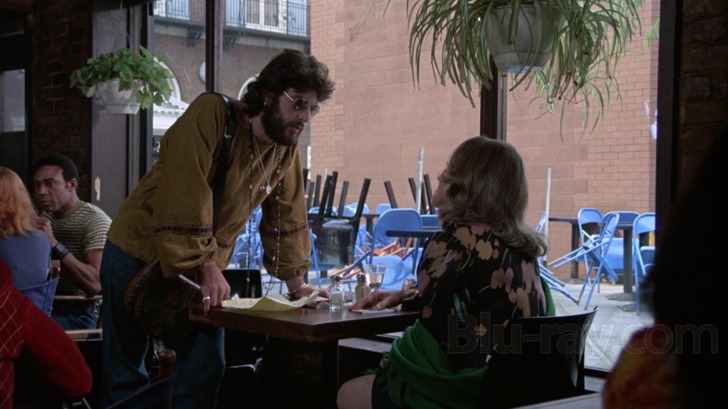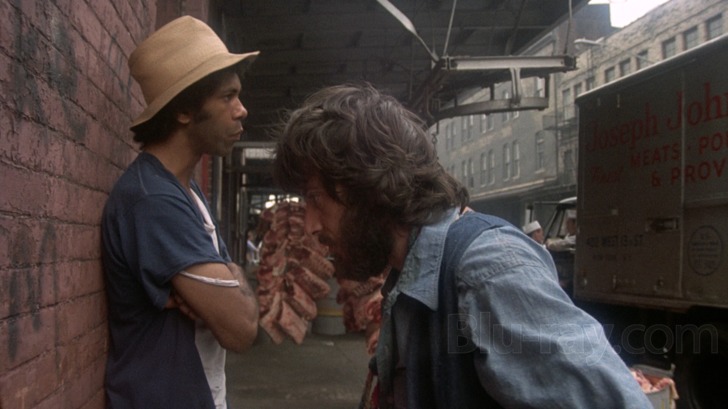Serpico Blu-ray Movie
HomeSerpico Blu-ray Movie 
Warner Bros. | 1973 | 130 min | Rated R | Dec 03, 2013
Movie rating
7.8 | / 10 |
Blu-ray rating
| Users | 4.0 | |
| Reviewer | 4.5 | |
| Overall | 4.4 |
Overview
Serpico (1973)
An honest New York cop blows the whistle on rampant corruption in the force only to have his comrades turn against him.
Starring: Al Pacino, John Randolph, Jack Kehoe, Biff McGuire, Barbara Eda-YoungDirector: Sidney Lumet
| Drama | Uncertain |
| Crime | Uncertain |
| Biography | Uncertain |
Specifications
Video
Video codec: MPEG-4 AVC
Video resolution: 1080p
Aspect ratio: 1.78:1
Original aspect ratio: 1.85:1
Audio
English: DTS-HD Master Audio 5.1 (48kHz, 24-bit)
English: Dolby Digital 2.0 Mono (Original) (224 kbps)
Spanish: Dolby Digital 2.0 Mono (224 kbps)
French: Dolby Digital 2.0 Mono (224 kbps)
Subtitles
English SDH, French, Spanish
Discs
50GB Blu-ray Disc
Single disc (1 BD)
Playback
Region free
Review
Rating summary
| Movie | 4.5 | |
| Video | 4.5 | |
| Audio | 4.5 | |
| Extras | 2.5 | |
| Overall | 4.5 |
Serpico Blu-ray Movie Review
The Loneliness of the Honest Cop
Reviewed by Michael Reuben November 26, 2013Serpico is a biography, a police drama and a morality tale about the high price exacted from someone who refuses to "go along and get along" with a corrupt system. It's also the film that cemented Al Pacino's reputation as a movie star. Whenever someone says that Pacino plays every role the same way, it's obvious they've never seen Serpico, where Pacino richly embodied the troubled and long-suffering cop who blew the whistle on hundreds of his fellow officers, sacrificing his own career, risking his life on a daily basis and ultimately sustaining crippling injuries as a result of his commitment to the ideals he'd sworn to uphold. Pacino monopolizes the screen for over two hours, and much of his performance consists of Frank Serpico's inner turmoil over how to deal with the impossible situation in which he finds himself trapped. Audiences were electrified, and a film that no studio wanted to make became a major hit when it was released in December 1973. Oscar nominations followed for Pacino and for the screen adaptation by Waldo Salt (Midnight Cowboy) and Norman Wexler (Saturday Night Fever) from the biography by Peter Maas. But the success and artistic endurance of Serpico aren't just a credit to its star. The late Sidney Lumet, who replaced John Avildsen as Serpico's director during pre-production, was a subtle craftsman in the tradition of Billy Wilder. Lumet once declared bluntly: "I hate style that shows." As a result, his achievements were frequently overshadowed by the bold visual experiments of Seventies contemporaries like Spielberg, DePalma, Scorsese and Coppola. Several decades later, with the release of what turned out to be his final film, Before the Devil Knows You're Dead, Lumet's unobtrusive camera placements and grasp of dramatic rhythm had become so rare that they suddenly seemed revolutionary. Lumet's strengths were rarely displayed to greater advantage than in Serpico, where he framed the tormented cop's struggles against carefully chosen locations of a New York City already sliding toward the financial and social breakdown that would render it synonymous with urban blight for the next twenty years. (The low point was President Gerald Ford's 1975 refusal of a federal bailout, resulting in the famous Daily News headline: "Ford to City: Drop Dead".) Lumet made it seem that the moral rot against which Serpico was battling had eaten away at the city's very foundation, as if corruption had taken tangible form.

The film opens with Frank Serpico (Pacino) being rushed to the hospital in the back of a police car. Semi-conscious, Serpico is covered in blood from a ghastly wound where he's been shot in the face. Chief Sidney Green (John Randolph) is called, and he orders a police guard outside Serpico's room. As Frank fades in and out of consciousness, the film slips into the past, back to Frank's graduation from the police academy and the celebrations with his Italian immigrant family. One of Serpico's daring narrative strategies is to be indefinite about time and place. In real life, Frank Serpico joined the NYPD in September 1959 and was shot in February 1971, but Lumet's film isn't particular about dates and times, although the clothing and general surroundings indicate the growth of Sixties counterculture, especially after Frank moves to an apartment in Greenwich Village. Nor does Lumet require the viewer to keep straight the various precincts through which Frank rotates during these years. Lumet even shoots one borough of New York for another (e.g., lower Manhattan for the Bronx), if he finds the setting more visually interesting. Specific dates and places don't matter, because wherever Frank Serpico goes in the NYPD, the situation never changes. From the moment he reports for his first day on duty, he discovers a system where payoffs from criminals—gamblers, numbers runners, drug dealers, etc.—are the norm and quid pro quo from local business owners (like free lunches if they overlook double-parked delivery vans) is standard procedure. Frank, too, remains the same. He has a rigid code of morality, and he wants no part of any of this. He spends the early part of his career looking for a "clean" station, where he can fight crime, not take money and be accepted simply as a cop who does his job. Eventually Frank realizes there isn't a clean station. This is how the NYPD works, and no one in the department wants anything changed. A cop who refuses to participate is viewed with suspicion and hostility. Corruption is tolerated at the highest levels of the department, so that every effort that Frank makes to seek assistance through proper channels disappears into a void (usually after profuse thanks for his honesty and bravery in coming forward). Even when, against all odds, a grand jury hearing is convened, the prosecutor (Allan Rich) limits his questions to a few beat cops and refuses to ask about higher-ups. When Serpico steps outside the department, at the urging of his attorney friend Bob Blair (Tony Roberts), who works in the Mayor's office, that too goes nowhere. The political costs are too high. Frank's private life gradually collapses under the strain of maintaining his integrity in an increasingly hostile work environment. This is particularly evident in his relationship with Laurie (Barbara Eda-Young), the second of two women with whom he is involved while a member of the NYPD. It is Laurie who bears the brunt of Frank's growing frustration with the department. As his feud with the force consumes him, it leaves no room for anyone else. What began as a light-hearted flirtation over coffee and opera ends in tears at a local cafe. After years of failed promises by his supposed mentor, Captain McClain (Biff McGuire), and the do-nothing police commissioner (Charles White), Frank finally yields to Blair's entreaties to go public with his allegations by speaking to the press. The fallout is dramatic. The Mayor appoints the Knapp Commission, which eventually leads to indictments and dramatic reforms in the NYPD. And Frank Serpico gets shot in the face—which brings us back to where the film opened. For a film that dwells in such serious territory, Serpico also has a comical side. Its best jokes come from Serpico's work undercover, a type of assignment he actively pursues because, as a kid from Brooklyn, he knows how to blend in with the crowd. Lumet's camera routinely finds him in some outlandish getup, including (in a memorable scene) the black garb and beard of a Hasidic Jew. Underneath each disguise, however, Serpico remains constant, unchanging and reliable: one of the few incorruptible elements in a system where everything is for sale, and moral boundaries have been erased.
Serpico Blu-ray Movie, Video Quality 

For Serpico, director Lumet reunited with Arthur J. Ornitz, his cinematographer from The Anderson Tapes, who made photographing the crumbling streets of New York something of a specialty in the Seventies with films like Death Wish, Next Stop, Greenwich Village and An Unmarried Woman. In contrast to the energetic, stylized photography displayed in The French Connection just a few years earlier, Lumet and Ornitz framed Serpico's scenes precisely but unobtrusively, so that viewers seem to be casual eyewitnesses to scenes on the street, in offices and precincts or in Frank Serpico's apartment. Warner has delivered an impressive 1080p, AVC-encoded Blu-ray of Serpico, working from a capable Paramount transfer. There are those in the Blu-ray community who are given to opining on the age of a transfer, based solely on examination of the Blu-ray image. I find that to be an exercise in guesswork, absent information from the studio, which was not available here. I also think it's irrelevant. If an image harvest was capably performed, it doesn't matter whether it was done yesterday or years ago. What matters is how the raw data has been handled since then. The technical crew that processed Serpico has created a film-like image that is detailed and, for a film of this era, as sharp as it can be without the application of electronic enhancements that would change the film's original look. The image has not been subjected to high frequency filtering or other digital processing that leaves obvious artifacts. The color correction accurately reproduces the flat urban palette of browns, rusts and dull grays and blues in the outer boroughs where Serpico spent most of his career. Brighter hues appear occasionally (e.g., at Frank's graduation, or during a lengthy party scene), but nothing in Serpico "pops", nor should it. Everyone has their own idea of what constitutes "demo" material. For many viewers, it's a brightly colored landscape or a special effects extravaganzas. For me, it's the precision with which a disc like Serpico replicates scenes such as Frank's meeting with Bob Blair in the magnificent but deserted Lewisohn Stadium amphitheater, which was demolished shortly after filming, or the scene where Frank's captain abandons him under the Hell Gate Bridge in Queens, two lone figures in the distance. Such scenes are dramatically powerful, and their drama is expressed in visual terms, which is the essence of cinema. Blu-ray brings that content to the home theater in a way that hasn't been seen since Serpico was in theaters. The image has a natural-looking grain pattern that, I suspect, is finer than that of many release prints. Although there was ample additional space on the BD-50, Warner stuck to their usual range of compression, coming out at the high end with an average bitrate of 25.95 Mbps. Certainly the image did not display any artifacts.
Serpico Blu-ray Movie, Audio Quality 

Serpico was released in mono, which is available in a two-channel version as Dolby Digital 2.0 (listed as "restored mono") with identical left and right front channels. The default audio track is lossless DTS-HD MA 5.1, which contains a very conservative remix of the mono track that retains the front-oriented nature of the mix, but uses the channel separations to give a little more authority and somewhat deeper bass extension to the score by Mikis Theodorakis (Zorba the Greek). The score is used sparingly, a point discussed by Lumet in the extras. The soundtrack is dominated by dialogue (which is clear), sound effects and occasional source music.
Serpico Blu-ray Movie, Special Features and Extras 

The extras have been ported over from Paramount's 2002 DVD edition (and appear to be entirely different from those on the Region B-locked Studio Canal disc released in January 2011).
- Serpico: From Real to Reel (480i; 1.33:1; 9:58): In separate interviews, Lumet and producer Martin Bregman discuss the genesis of the project, the evolution of the script and the early involvement of John Avildsen.
- Inside Serpico (480i; 1.33:1; 12:55): Again in separate interviews, Lumet (primarily) and Bregman discuss the logistics of production and post-production (which was happening almost simultaneously with shooting), as well as Pacino's approach to the role.
- Serpico: Favorite Moments (480i; 1.33:1; 2:38): Lumet and Bregman each identify favorite scenes from the film.
- Photo Gallery with Commentary by Director Sidney Lumet (480i; 1.33:1; 4:24): The photos are primarily lobby cards, but the commentary recounts the fascinating debate between Lumet and executive producer Dino De Laurentiis about whether the film should have music at all. (Lumet wanted none.) It was Lumet's idea to recruit Theodorakis, who had just been released from prison in Greece by the military junta, and he describes their collaboration.
- Theatrical Trailer (480i; 1.78:1; 4:16): Perhaps the most notable feature of the trailer is its heavy reliance on still photos.
Serpico Blu-ray Movie, Overall Score and Recommendation 

In addition to being a career highpoint for both Pacino and Lumet, Serpico has become one of the essential films of the Seventies, an intense character study of a peculiarly American hero, the lone man of integrity, in the unexpected genre of a police drama. Timing was undoubtedly a factor in the film's popular success. As I recently had reason to reflect in reviewing the new documentary accompanying the reissue of All the President's Men, 1973 was the year when America watched Richard Nixon's Presidency collapse as revelations of illegal and immoral behavior arrived in continuous waves, until it seemed that no institution had been spared from what White House counsel John Dean called "a cancer" on the nation's highest office. Coming off that year, audiences were prepared to cheer the steadfastness of a lone crusader against a corrupt system. Serpico's unyielding commitment to doing the right thing, whatever the cost, still resonates. Highly recommended.
Similar titles
Similar titles you might also like

The Informant! 4K
2009

Mean Streets 4K
1973

Red Riding: The Year of Our Lord 1974
2009

The Place Beyond the Pines 4K
2012

The Irishman
2019

GoodFellas
1990

The Fifth Estate
2013

Bad Lieutenant 4K
1992

If Beale Street Could Talk
2018

Carlito's Way 4K
1993

Blue Collar
1978

The Taking of Pelham One Two Three 4K
1974

American Gangster 4K
2007

State of Grace
1990

Blood Ties
2013

Crash: The Complete First Season
2008

The Narrows
2008

The Miami Story
1954

BlacKkKlansman 4K
2018

A Prophet
Un prophète
2009

